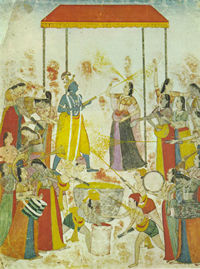
The Holi Festival. Chamba miniature, 26×22 cm. Collection: London, Victoria and Albert Museum. Krishna, Radha and Gopis playing Holi
Though India is often and justly described as a land of many religions and innumerable languages, it might well be described as a land of festivals as well. One conventional authority, the Encyclopedia Brittanica, rather unabashedly and with the customary cavalier attitude with which India can be treated, says of Hindu festivals that these are combinations of religious ceremonies, semi-ritual spectacles, worship, prayer, illustrations, processions (to set something sacred in motion and to extend its power throughout a certain region), music, dances (which by their rhythm have a compelling force), magical acts — participants throw fertilizing water or, during the Holi festival, coloured powder at each other — eating, drinking, lovemaking, licentiousness, feeding the poor, and other activities of a religious or traditional character. No example is adduced of “lovemaking”, but one might reasonably infer that the reference is to some tantric practices.
As in any old civilization, most of these festivals have religious associations, as is the case with Holi, Dusshera, Krishna Janmashtmi, Hanuman Jayanti, Ganesh Chaturthi, Muharram, Shivratri, and Diwali or Deepavali; many are also, in a country which is still predominantly rural, associated with the harvesting of the crop, as is true of Pongal-Sankranti in South India, or otherwise commemorative of the sacred ties with the land that Indian villagers have. Still others, such as Karwa Chauth, the observance of which is strictly restricted to Hindu married women, are not festivals as such though there may be something of a festive air attached to these occasions. Some festivals are observed throughout the country, or in a greater part of it; others, such as the famed snake race of Kerala, have peculiarly regional associations. Yet others, most notably Diwali and Holi, have been instrumental in forging ties among older diasporic Indian communities, and in such far-flung places as Fiji, Mauritius, Trinidad, Jamaica, and Guyana, these festivals are celebrated with a pomp and vigor not always witnessed in India itself.

